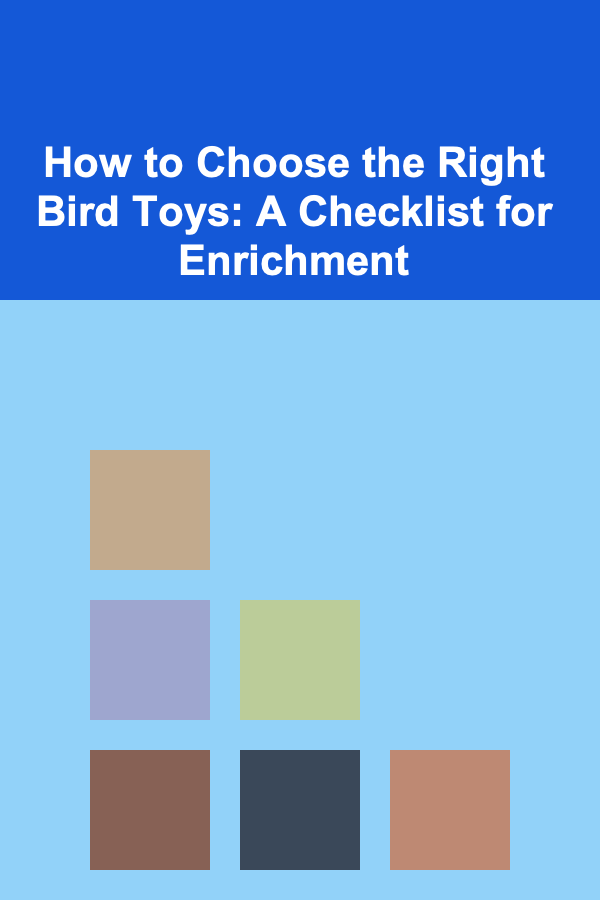
How to Choose the Right Bird Toys: A Checklist for Enrichment
ebook include PDF & Audio bundle (Micro Guide)
$12.99$9.99
Limited Time Offer! Order within the next:

Birds, particularly pet birds, require mental stimulation and physical activity to thrive. Just as humans benefit from entertainment, interaction, and exercise, birds too need activities that allow them to express their natural behaviors, stay healthy, and feel secure. One of the best ways to achieve this is through providing bird toys that meet their unique needs. Choosing the right bird toys, however, can be overwhelming due to the variety of options available. In this article, we'll explore how to select the right toys for your feathered friend, providing a detailed checklist for bird toy enrichment.
Understand Your Bird's Species and Personality
The first step in selecting the right bird toys is to understand your bird's species, size, and individual personality. Birds come in all shapes and sizes, from small budgies to large macaws, and each type of bird has its own set of preferences and needs when it comes to toys.
Key Considerations:
- Size of the Bird: Larger birds, such as cockatoos, African Greys, and macaws, require larger, sturdier toys due to their stronger beaks. Smaller birds, such as budgies or finches, need smaller, gentler toys that suit their size.
- Species-Specific Needs: Some birds are more inclined to chew, while others may enjoy foraging or puzzle-solving. For example, parrots are known for their intelligence and curiosity, requiring interactive and mentally stimulating toys. On the other hand, species like canaries may enjoy more simple toys such as swings or mirrors.
- Individual Preferences: Not all birds are the same, even within the same species. Some birds may love to chew, others may prefer toys that they can climb on, and some might prefer quiet toys that they can manipulate. Observing your bird's behavior and preferences is essential when selecting toys.
Key Questions to Ask:
- What species is your bird, and what are their specific behavioral traits?
- Does your bird show any clear preferences for particular types of toys or activities?
Prioritize Safety
Birds have an innate curiosity that often leads them to explore and interact with everything in their environment, including their toys. As such, safety should always be the top priority when selecting bird toys. Toys that are made from unsafe materials can pose significant risks to your bird's health.
Key Safety Considerations:
- Non-Toxic Materials: Ensure that the toys are made from bird-safe, non-toxic materials. Common bird-safe materials include natural wood, untreated leather, sisal, and cotton. Avoid toys made from toxic substances like lead, zinc, or plastic containing phthalates.
- No Small Parts: Toys should not have small parts that could be swallowed or pose a choking hazard. This is especially important for small birds like budgies, cockatiels, or finches.
- Sturdy Construction: Ensure the toys are durable and won't break apart easily, as broken pieces can cause injury to your bird.
- Avoiding Sharp Edges: Check that toys don't have sharp edges that might hurt your bird's beak, feet, or feathers.
Key Questions to Ask:
- Are the materials used in the toys safe for birds?
- Is there any risk of the toy breaking apart or containing small parts that could harm my bird?
Choose Toys that Encourage Natural Behaviors
Birds have evolved to perform a wide range of behaviors in the wild, including foraging, chewing, climbing, and socializing. Providing toys that allow your bird to express these behaviors is crucial for their physical and mental well-being. When choosing toys, think about the ways your bird behaves naturally.
Types of Natural Behaviors to Encourage:
- Chewing: Many birds love to chew, especially species like macaws and cockatoos. Offering chewable toys made of natural wood, leather, and sisal rope will not only satisfy this instinct but also help prevent destructive chewing behavior in the cage.
- Foraging: In the wild, birds spend a significant amount of time foraging for food. Foraging toys simulate this behavior by hiding treats inside them, which encourages your bird to search, manipulate, and solve puzzles.
- Climbing and Swinging: Birds naturally climb and explore vertical spaces. Toys such as ladders, swings, and ropes provide opportunities for your bird to engage in these behaviors.
- Preening and Grooming: Birds love to preen themselves and other birds in their flock. Providing toys with soft materials, such as feathers, allows birds to preen and satisfy their grooming instincts.
Key Questions to Ask:
- Does the toy allow my bird to engage in behaviors such as chewing, foraging, climbing, or preening?
- Does the toy provide enough stimulation to keep my bird occupied and mentally engaged?
Size and Durability of the Toy
One of the most important factors in selecting the right bird toy is size. Choosing a toy that is appropriately sized for your bird will ensure they can interact with it safely and enjoyably.
Key Size Considerations:
- Bird Size: Large birds require larger and more durable toys that can withstand their strong beaks and biting power, while smaller birds need smaller toys that fit in their beaks. For example, a toy suitable for a budgie will likely be too small and fragile for a macaw.
- Toy Durability: A toy should be able to withstand your bird's beak strength. Birds like cockatoos or macaws can break apart weaker toys quickly, so selecting toys made from tough materials like hardwood, acrylic, or stainless steel is essential for these larger species.
Key Questions to Ask:
- Is the toy the right size for my bird?
- Will it withstand the chewing or destruction habits of my bird?
Look for Toys that Promote Social Interaction
Many pet birds are social creatures and enjoy interacting with their human caregivers and other birds. Social interaction is not only a great way to bond with your bird but also helps reduce loneliness and stress. Selecting toys that promote these interactions can significantly enhance your bird's emotional health.
Types of Social Interaction Toys:
- Interactive Toys: Toys that require the bird to work with you or others, such as toys that release treats when the bird interacts with them, can foster bonding and engagement.
- Mirrors and Perches: Some birds enjoy the company of their own reflection, so mirrors can provide entertainment and comfort. However, be careful not to rely too heavily on mirrors, as they can sometimes cause frustration or overbonding with the reflection.
- Foraging Toys: Foraging toys can encourage interaction with both the bird's environment and their caregiver. You can hide treats in these toys, prompting your bird to interact and engage with you while retrieving the reward.
Key Questions to Ask:
- Does the toy encourage socialization with my bird?
- How can I use this toy to bond with my bird and stimulate interaction?
Vary the Types of Toys for Enrichment
Birds, like humans, can get bored with the same toys over time. Variety is key to keeping your bird engaged and mentally stimulated. By rotating different types of toys in and out of the cage, you can ensure that your bird never feels monotonous in their environment.
Types of Toys to Rotate:
- Chew Toys: Switch out different chew toys made from a variety of materials, including wood, leather, and paper.
- Puzzle Toys: Introduce puzzle toys that challenge your bird to think and problem-solve, keeping their brain sharp.
- Toys for Climbing and Swinging: Regularly change the swings, ladders, and ropes in your bird's cage to keep them physically active.
- Noise-Making Toys: Some birds enjoy toys that make noise, like bells or rattles. However, be cautious with these as too much noise can cause overstimulation or stress.
Key Questions to Ask:
- Do I have a variety of toys to keep my bird engaged and mentally challenged?
- Am I rotating toys regularly to prevent my bird from getting bored?
Consider the Type of Material
When selecting bird toys, the materials used play a significant role in both the safety and enjoyment of your bird. The wrong material can be harmful to your bird's health, while the right material can contribute to a stimulating and enriching environment.
Safe Materials for Bird Toys:
- Wood: Untreated natural wood is an excellent choice for chew toys, as it's safe for birds and helps to keep their beaks healthy.
- Cotton: Cotton ropes and threads can be used for climbing and hanging toys, but ensure that they are not made with synthetic chemicals or dyes.
- Leather: Leather strips are often used for chew toys, but ensure they are free from toxic dyes or chemicals.
- Sisal: This natural fiber is safe for chewing and can be used in toys that require birds to manipulate or chew on them.
- Plastic (Acrylic): Hard acrylic is a good option for toys that need to be durable and easy to clean. However, ensure that it is free from harmful chemicals like phthalates.
Key Questions to Ask:
- What materials is the toy made from, and are they safe for my bird to interact with?
- Are the materials natural and free from harmful chemicals or dyes?
Observe Your Bird's Reaction
After introducing new toys, it's crucial to observe how your bird reacts to them. This can provide insights into whether the toy is enjoyable, stimulating, or appropriate for their behavior. Some birds may immediately take to a new toy, while others may need time to explore it.
Key Things to Look For:
- Engagement: Does your bird show interest in the toy, or does it ignore it? If your bird seems uninterested, try offering a different type of toy or move it to a different part of the cage.
- Comfort: Is your bird using the toy in a way that seems natural, such as chewing, foraging, or playing? If your bird appears distressed or afraid of the toy, it may not be the right choice.
- Physical Activity: Is the toy encouraging your bird to engage physically, such as climbing, swinging, or chewing? If not, it may not be providing sufficient enrichment.
Key Questions to Ask:
- How does my bird interact with the toy?
- Is it engaged with the toy, or does it seem hesitant or scared?
Conclusion
Choosing the right bird toys is a crucial aspect of keeping your pet bird happy and healthy. By understanding your bird's species, personality, and natural behaviors, and by prioritizing safety, variety, and enrichment, you can create a stimulating environment that enhances their quality of life. The right toys will not only entertain your bird but also provide them with essential mental and physical exercise, ensuring that they remain active, engaged, and content. By using the checklist outlined in this article, you can confidently select toys that meet your bird's needs and keep them enriched for years to come.
Reading More From Our Other Websites
- [Personal Care Tips 101] How to Use Mouthwash to Support Healthy Gums During Pregnancy
- [Home Party Planning 101] How to Capture Great Photos During Your Party
- [Home Pet Care 101] How to Set Up a Pet-Sitting Routine for When You're Away
- [Organization Tip 101] How to Create an Easy Access Area for Frequently Used Supplies
- [Reading Habit Tip 101] Beyond the Summary: How Book Journaling Boosts Memory and Insight
- [Rock Climbing Tip 101] Injury Prevention in Bouldering: Warm-ups, Stretching, and Recovery Tips
- [Personal Finance Management 101] How to Apply Frugal Living Tips to Your Grocery Bill and Cut Costs Significantly
- [Home Space Saving 101] How to Make the Most of Your Space with a Bunk Bed with Built-In Storage
- [Toy Making Tip 101] The Ultimate Toy-Making Bucket List: Projects That Bring Joy and Nostalgia
- [Polymer Clay Modeling Tip 101] The Art of Detail: Advanced Techniques for Realistic Clay Sculptures

How to Create a Backyard Camping Experience for the Family
Read More
How To Declutter Your Craft Supplies and Hobbies
Read More
How To Master Video Export Settings
Read More
How to Understand the Premium Tax Credit Reconciliation Process
Read More
How to Thank Your Volunteers with Heartfelt Cards
Read More
10 Tips for Effective Time Management as a Sales Representative
Read MoreOther Products

How to Create a Backyard Camping Experience for the Family
Read More
How To Declutter Your Craft Supplies and Hobbies
Read More
How To Master Video Export Settings
Read More
How to Understand the Premium Tax Credit Reconciliation Process
Read More
How to Thank Your Volunteers with Heartfelt Cards
Read More